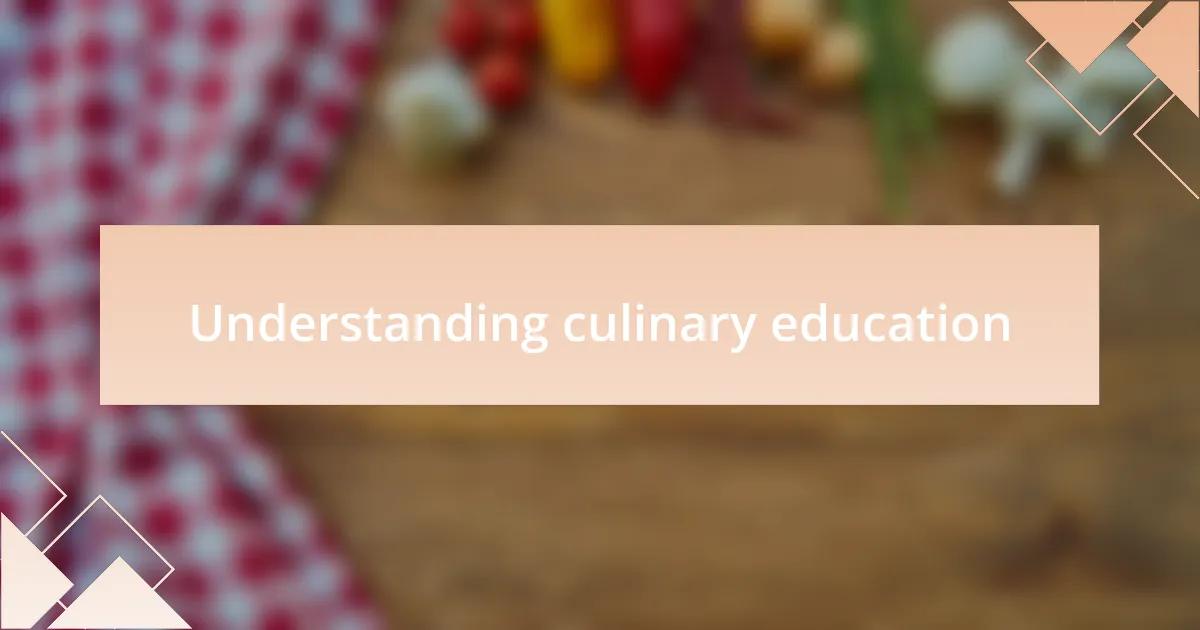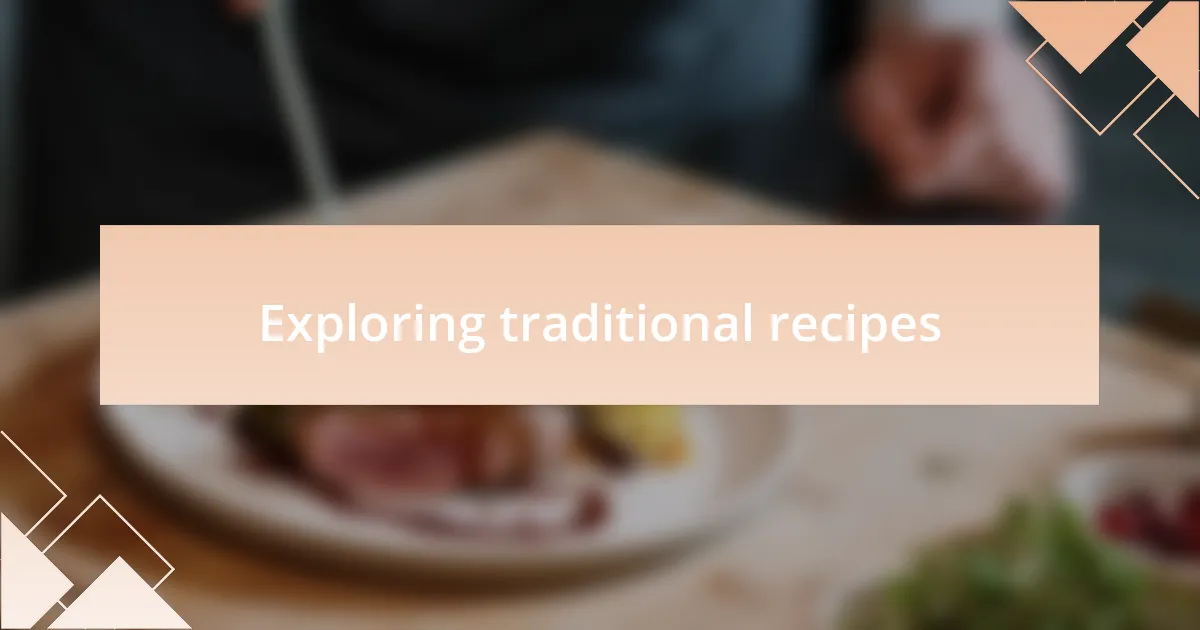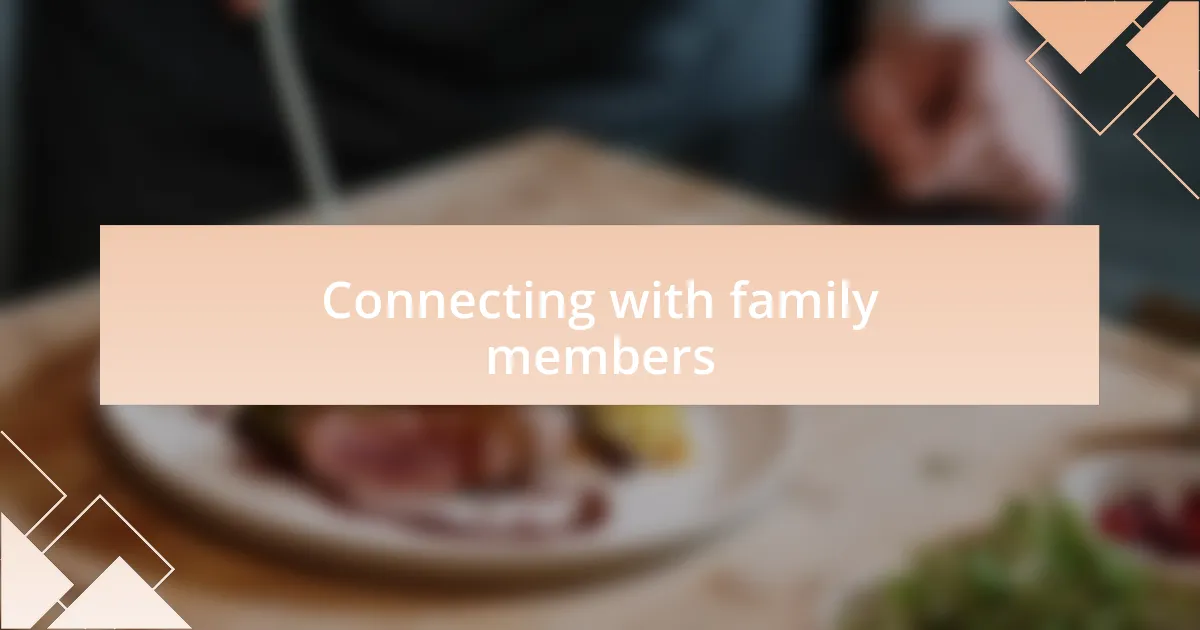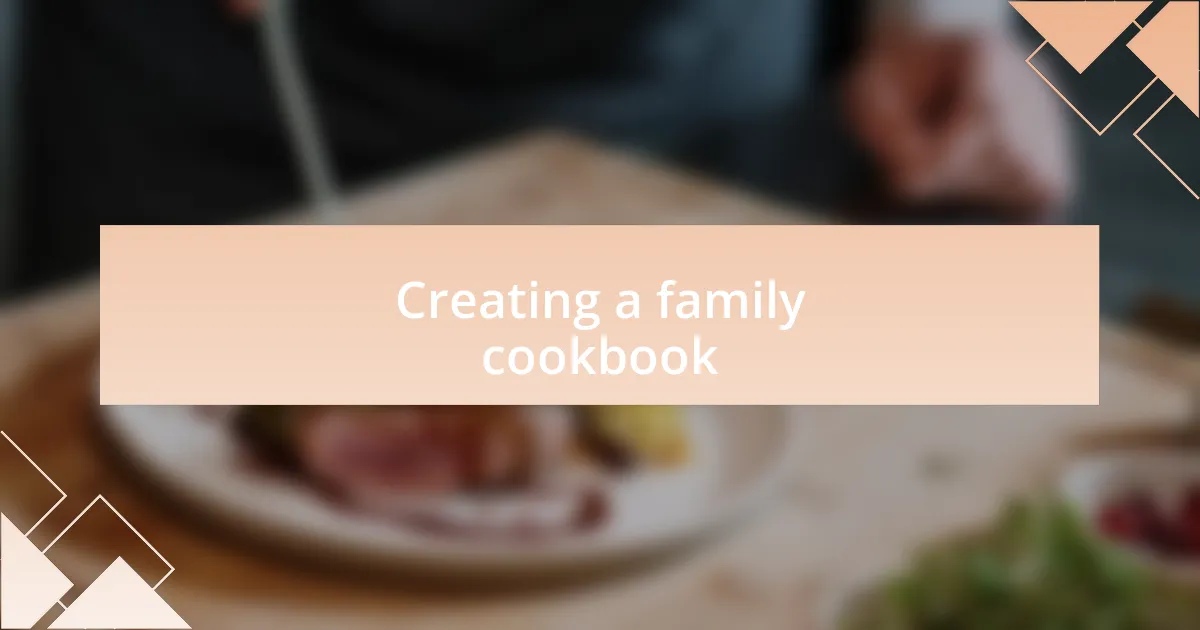Key takeaways:
- Culinary education encompasses techniques, cultural stories, and personal memories, creating a deeper connection to food.
- Exploring culinary heritage fosters family bonding and preserves traditions, enriching identities through shared cooking experiences.
- Documenting family recipes and stories transforms them into a legacy, ensuring future generations can continue culinary traditions.
- Creating a family cookbook captures not only recipes but also the emotional narratives and memories tied to those dishes, reinforcing familial connections.

Understanding culinary education
Culinary education is more than just learning to cook; it’s about understanding the story behind each dish. I remember my first day in culinary school, the air thick with the scent of fresh herbs and baked bread—it felt like stepping into a vibrant world where foods tell tales of culture and tradition. Have you ever considered how a recipe can carry the essence of generations?
In my journey, I often reflect on the ingredients I used in my family’s kitchen, each with its own significance. My grandmother taught me how to make her famous pasta from scratch, not just as a practical skill, but as a rite of passage that connected me to my heritage. That experience made me realize how culinary education encompasses not only techniques but also the emotions and memories intertwined with food.
Moreover, culinary education encourages creativity and innovation. I’ve felt that moment of inspiration when I attempted to reinvent a childhood dish, blending flavors that speak to my roots while adding a twist of my own. Isn’t it fascinating how we can honor the past while carving out our own culinary identity? Each exploration in the kitchen deepens our understanding and connection to food, making it an exhilarating adventure.

Importance of culinary heritage
Culinary heritage serves as a bridge to our past, offering a profound sense of identity and belonging. I vividly recall the family gatherings where recipes were passed down, each dish eliciting stories and laughter that brought us closer together. Have you ever felt how a single taste can transport you back to cherished moments in your childhood?
Understanding where our food comes from allows us to appreciate the labor and love that went into creating it. For me, making my mother’s spicy curry was not just a cooking lesson; it was a heartfelt connection to my roots, a culinary journey back to her childhood kitchen, filled with the aromas of her ancestors. This connection fosters respect for the diverse cultures that enrich our world.
Furthermore, preserving culinary heritage can inspire future generations to explore their own roots. Whenever I prepare a family recipe, I invite my children into the kitchen to share in the experience. I often ask them, “What do you think makes this dish special?” Their excitement as they learn these traditions gives me hope that they will carry forth our culinary legacy and create their own in the years to come. Isn’t it incredible how something as simple as cooking can weave together the fabric of our family history?

Researching your family history
Delving into my family’s culinary history began with a simple curiosity about where my grandparents grew up. I spent weekends poring over old family photos and chatting with older relatives, eager to unearth memories associated with food. Have you ever looked at a faded photograph and imagined the life behind it? For me, it was in these stories that the aromas of classic dishes came alive, taking me back in time.
As I gathered information, I discovered my grandmother’s handwritten cookbook tucked away in a dusty attic. It was bursting with vibrant notes and slight stains, each recipe a testament to her adventures in the kitchen. Every time I tried one of her dishes, I felt like I was not just tasting the food, but tasting her joy and struggles. Isn’t it fascinating how a collection of ingredients can weave together personal stories, illustrating resilience and love?
Recently, I created a family tree that didn’t just map out names and dates but included the meals that marked those occasions. Sharing this with my children ignited their curiosity about our lineage. They would often ask, “What did Grandma serve at her wedding?” This art of conversation transformed what initially felt like a history project into a joyful exploration, enriching our connection to both our family and our culinary practices.

Exploring traditional recipes
Exploring traditional recipes turned into a delightful treasure hunt for me. One Sunday afternoon, as I flipped through my grandmother’s cookbook, I stumbled upon a recipe for her famous gnocchi. I vividly recall my first attempt at making these little dumplings; the overwhelming mix of excitement and anxiety was palpable. Have you ever felt a dish connect you so deeply to your past? That day in the kitchen was a bridge across time, as I envisioned my grandmother guiding me through every step.
As I cooked, flour dust clouded the kitchen, almost like a spell connecting the generations. It became clear that the ingredients were not just elements of a recipe; they were echoes of family gatherings and laughter-filled meals. One bite of those gnocchi transported me back to crowded dining tables, filled with love and warmth. After all, isn’t it incredible how a simple meal can evoke such vivid emotions and memories?
There are moments when I’ve invited family to join in the cooking process, and it transformed into a collaborative storytelling session. As we chopped vegetables and stirred pots, I shared tales of my ancestors and their culinary traditions. Each recipe became a narrative, rich with history and personal significance. Isn’t this how we can keep traditions alive, not just through ingredients but through shared experiences?

Connecting with family members
Cooking has an incredible way of drawing family members closer together. I remember one holiday season, gathering in my aunt’s cozy kitchen, where the aroma of spices danced in the air. As we collected recipes from different hands in the family, it turned into a lively exchange of stories—each dish was steeped in memories that sparked laughter and fond recollections. Isn’t it fascinating how the act of cooking can serve as a canvas for our shared history?
There was a time when my cousin and I decided to recreate our family’s traditional tamale recipe, a dish steeped in cultural significance. While we rolled the masa, we laughed over childhood tales and the culinary mishaps of our relatives. It struck me that this wasn’t just about food; it was about weaving together our identities. Could there be a more beautiful way to honor our heritage than through the flavors that shaped our family’s narrative?
In another instance, I reached out to a distant relative I had never met, who had lovingly preserved our great-grandmother’s recipes. Through video calls, we connected over a simmering pot of her beloved chili. Every stir felt like a dialogue, linking generations and sharing secrets that had long been forgotten. How often do we miss the chance to connect through something as simple yet profound as cooking together?

Documenting your findings
Documenting your culinary discoveries is a rewarding process that brings clarity to your family’s food history. I often found myself jotting down notes as I listened to my relatives sharing their favorite recipes. Each time I recorded a dish, I also noted the stories that accompanied it, like the chopping of onions that made my grandmother cry or the secret ingredient my uncle swore would bring good luck. Have you ever thought of how these little extra details can transform mere recipes into a tapestry of memories?
As I sifted through old recipe cards and faded notebooks, I stumbled upon my grandfather’s handwriting, meticulous and bold. It felt like I was conversing with him again, almost like he was there guiding me through every step. I couldn’t help but feel a rush of nostalgia—how many moments in the kitchen were shared over those instructions? Writing them down made me feel like I was honoring his legacy, capturing the essence of his culinary artistry for future generations.
In addition to writing down the recipes, I took it a step further and created a digital archive. This way, I not only preserved the flavors but also included photos of the dishes and the family members who cherished them. As I compiled this collection, I realized that it was more than just documentation; it was sealing the bond between past and present, making it accessible to anyone in the family who might want to continue the tradition. Isn’t it empowering to think that through careful documentation, we can inspire future generations to carry on the culinary tales we hold dear?

Creating a family cookbook
Creating a family cookbook is a heartfelt endeavor that allows you to preserve not just recipes but the very essence of your family’s culinary history. I remember sitting at my kitchen table, surrounded by scattered notes, as I combined my grandmother’s beloved lasagna recipe with her handwritten anecdotes. Each ingredient became a reminder of Sunday dinners filled with laughter and love—how could I ensure these moments did not fade away?
When I began compiling our family cookbook, I decided to include spaces for personal reflections alongside each recipe. I encouraged my family members to share their own stories, adding a layer of connection and nostalgia to the pages. It was fascinating to see how my siblings had their own memories tied to dishes that I had never associated with them; it opened a window into their experiences and perspectives—have you ever realized how a single dish can evoke a multitude of different emotions across generations?
The design of the cookbook was as important to me as the recipes themselves. I opted for a cozy, handmade feel, complete with family photographs and sketches drawn by my children of their favorite dishes. This personal touch made the project more than just a collection of recipes; it became a narrative that told the story of our family’s love for cooking. Every time I flip through its pages, I feel a warmth in my heart, reminding me that food isn’t just about nourishment—it’s about connection, heritage, and the stories we share together.